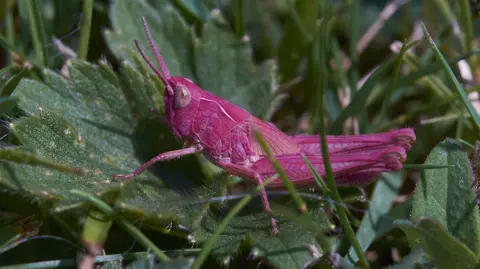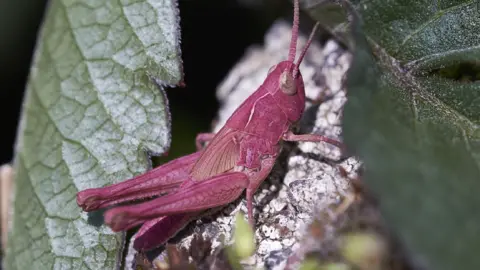Rare pink grasshopper spotted in garden
 Gary Phillips
Gary Phillips- An amateur photographer was captivated by a sight he had never encountered before - a pink grasshopper
- They are created by a rare genetic mutation, but usually do not survive long as predators easily spot them
- While some experts say people have a 1% chance of seeing them in their lifetime, recent warm weather may mean more survive for longer
An amateur photographer was stunned after he spotted a rare pink grasshopper at the bottom of his garden.
Gary Phillips, 65, was pruning his dahlias in Llandegfan, Anglesey, when he was shocked by the "vivid colour" of the insect.
"I'd never heard of them," said Mr Phillips, who then crawled across his garden with his camera to snap some pics.
Some experts have suggested people have only about a 1% chance of seeing a pink grasshopper in their lifetime.
 Gary Philips
Gary Philips"I had to proper focus on what I'd seen, and realised it was a pink grasshopper which I thought has got to be rare," Mr Phillips added.
Despite its small size, the hot pink of the grasshopper stood out and Mr Phillips was captivated, watching it hop across his lawn.
The green meadow grasshopper species is common across the UK, however - as the name suggests - these are generally green, brown or a combination of the two.
It is believed on rare occasions, a genetic mutation causes them to turn pink.
This makes seeing them even rarer again, as their bright colours mean they are unable to hide from predators and do not survive very long.
Paul Hetherington, of conservation charity Buglife, said the pink grasshopper's colour is caused by a recessive gene that can be passed through successive generations.
It is known as erythrism, which causes too much red pigment and not enough black.
He explained that being pink in the wild is "not useful" for the insect as they stand out from the green grass.
'Just wonderful'
However, in the summer months, when the grass changes colour, it increases their survival chances as they are less noticeable.
While some experts have tried to describe how rare they are by saying people have a 1% chance of encountering them, Mr Hetherington said this is only true if you're not actively looking.
"If you look closely for them in any meadow, the chances of seeing them are actually very high," he said, adding that he has in fact seen three himself.
"It's amazing to see the beauty of the creatures being appreciated," he added.
"They are just wonderful."
